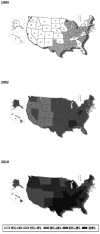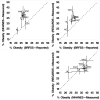The geographic distribution of obesity in the US and the potential regional differences in misreporting of obesity
- PMID: 23512879
- PMCID: PMC3866220
- DOI: 10.1002/oby.20451
The geographic distribution of obesity in the US and the potential regional differences in misreporting of obesity
Abstract
Objective: State-level estimates of obesity based on self-reported height and weight suggest a geographic pattern of greater obesity in the Southeastern US; however, the reliability of the ranking among these estimates assumes errors in self-reporting of height and weight are unrelated to geographic region.
Design and methods: Regional and state-level prevalence of obesity (body mass index ≥ 30 kg m(-2) ) for non-Hispanic black and white participants aged 45 and over were estimated from multiple sources: self-reported from the behavioral risk factor surveillance system (BRFSS 2003-2006) (n = 677,425), self-reported and direct measures from the National Health and Nutrition Examination Study (NHANES 2003-2008) (n = 6,615 and 6,138, respectively), and direct measures from the REasons for Geographic and Racial Differences in Stroke (REGARDS 2003-2007) study (n = 30,239).
Results: Data from BRFSS suggest that the highest prevalence of obesity is in the East South Central Census division; however, direct measures suggest higher prevalence in the West North Central and East North Central Census divisions. The regions relative ranking of obesity prevalence differs substantially between self-reported and directly measured height and weight.
Conclusions: Geographic patterns in the prevalence of obesity based on self-reported height and weight may be misleading, and have implications for current policy proposals.
Copyright © 2013 The Obesity Society.
Figures




References
-
- U.S. Obesity Trends. Centers for Disease and Prevention; Atlanta, GA: retrieved from http://www.cdc.gov/obesity/data/trends.html. Retrieved October 7, 2011.
-
- Yun S, Zhu BP, Black W, Brownson RC. A comparison of national estimates of obesity prevalence from the Behavoral Risk Factor Surveillance System and the National Health and Nutrition Examination Survey. International Journal of Obesity. 2006;30:164–170. - PubMed
-
- Centers for Disease Control and Prevention. Behavior Risk Factor Surveillance System. Available at: http://www.cdc.gov/brfss.
Publication types
MeSH terms
Grants and funding
LinkOut - more resources
Full Text Sources
Other Literature Sources
Medical

